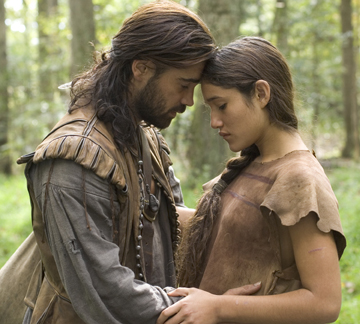 Colin Farrell and Q’orianka Kilcher find love in the Virginia woods in ‘the New World.’
Colin Farrell and Q’orianka Kilcher find love in the Virginia woods in ‘the New World.’
|
| The New World\r\nStarring Colin Farrell and Q’orianka Kilcher. Written and directed by Terrence Malick. Rated R. |
|
A D V E R T I S E M E N T
|
|
|
|
A D V E R T I S E M E N T
|
|
This Side of Paradise
Terrence Malick is \r\nstuck in the past in this soggy 17th-century epic.
By KRISTIAN LIN
There are basically two types of movies that you can look at all day. Some of them are comedies like Monty Python and the Holy Grail or The Big Lebowski, which are rewatchable because they’re so much fun. Then there are those movies that overwhelm your senses by using color, composition, rhythm, sound, and music so harmoniously that the story becomes secondary, and you can just sink into a chair and become immersed in the aesthetic experience.
Some people respond this way to Terrence Malick’s films, though I don’t. Whether his movies are about a killing spree or a domestic tragedy or a World War II battle, their real subject is always the same: the despoiling of Nature by the incursion of Man. (And I use that word in every sense. Malick’s world isn’t very female.) His languorous, self-consciously poetic style and his fetishizing of the natural world played pretty well in the 1970s when he first came up. His best career move, however, was disappearing for 20 years after he completed Days of Heaven in 1978. Making no new films and giving no interviews, he became the film world’s J.D. Salinger, the subject of wild rumor and speculation about where he was and what he was up to. After years of chatter over whether his lyrical filmmaking would ever grace the screen again, Malick resurfaced in 1998 with his over-long war film The Thin Red Line, which wasn’t quite worth the trade-off of breaking the mystique surrounding him. His latest work, The New World, sadly confirms that cinema has passed him by.
The New World is about the mythical love affair between John Smith (Colin Farrell) and the Powhatan Indian chief’s daughter Pocahontas (14-year-old newcomer Q’orianka Kilcher). Smith arrives with the crew of a British ship to set up the colony of Jamestown. After Pocahontas saves him from being killed by her father’s warriors, she and Smith learn each other’s language, keep the Indians and the colonial settlers at peace, and eventually fall in love. They express their love by floating down a river on a raft, holding each other and singing rapturously, “A whole new world! (Don’t you dare close your eyes!) / A dazzling place I never knew!”
Oh, just kidding. (Anyway, I’m quoting from the wrong Disney musical.) Before we go any further, I need to mention that the 134-minute version of The New World playing in theaters this week is about 16 minutes shorter than the one that was screened for me and other film critics last month. It seems unlikely that the shortened running time will make much difference — there’s so little story here that any 10 minutes of the film could easily be mistaken for any other 10 minutes. Malick treats his actors as merely compositional elements, objects to be placed in the foreground while cinematographer Emmanuel Lubezki’s adoring shots of the virgin American forest fill the background. The fuzzy, metaphysical voiceover narration unfortunately recalls Saturday Night Live’s “Deep Thoughts by Jack Handey,” and the soundtrack repeatedly plays the second movement of Mozart’s 23rd Piano Concerto to convey whatever emotion these inarticulate characters are supposed to be feeling. The music is beautifully melancholic but its constant use becomes a tic that seems meant to distract us from the movie’s essential emptiness.
Even worse, the filmmaker takes no discernible point of view on the events in this story. You almost wish he’d take the cheap “white people suck” option and bash the colonists, if only because it’d give this movie some sort of direction. Malick comes up with some striking visuals, like a Powhatan warrior (Wes Studi) in full tribal regalia wandering in amazement through a garden in London, but the filmmaker never bothers to clue us in on what they might mean. The romance between Smith and Pocahontas remains hazily theoretical, never threatening to become a relationship between two human beings. Neither the political power struggle in colonial Jamestown nor the introduction of Christian Bale as Pocahontas’ future husband John Rolfe does anything to interrupt the picture’s tone of unrelieved nature worship.
All we’re left with is a bunch of pretty pictures, which is sadly all that Malick has to offer, since everything substantial about his previous work has evaporated. Compare this film to his 1973 debut movie Badlands, with its crisp pacing and deft study of alienated youth, and you’ll see how far Malick has regressed as a filmmaker. What a shame that he didn’t take up another career. Arid and bereft of ideas, The New World might have made a good coffee-table book. As a movie, it’ll only put you to sleep.
 Email this Article...
Email this Article...

